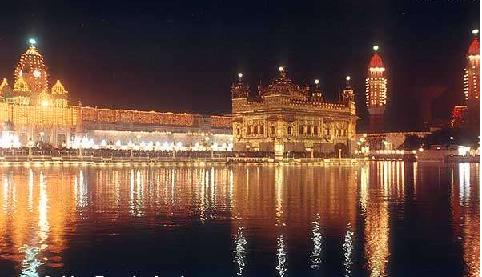| Connecting
over 25 millions NRIs worldwide |
|
|||||||||||||||||||||||
|
||
|
Inside the
Golden Temple, life moves on (25 years after Indira Gandhi's assasination) It has been 25 years since prime minister Indira Gandhi was assassinated
Oct 31, 1984 perhaps, as a consequence of Operation Bluestar at
Amritsar's Golden Temple four months earlier. Events of those days
are still fresh in memory. Consequently, over 1,200 workers from the municipal corporation were engaged in sprucing up the place. It was amidst this exercise that prime minister Indira Gandhi visited the Golden Temple on the morning of June 23. Local media persons were not allowed access to the complex. In fact the media was not permitted to cover the visit of even Zail Singh. The walled city was under tight security cover and even the movement of pedestrians was restricted. Deciding not to let the occasion be given a miss, my colleague, Gurdip Singh and I walked towards the walled city and reached near the footbridge when we saw a cavalcade of vehicles heading towards the army cantonment. Indira Gandhi was returning from the complex and was seated in the front seat of a white Ambassador car, wearing a white-bordered sari and goggles. We waved to her and she reciprocated. Minutes later, we were with Giani Sahib Singh, head priest of the Golden Temple, who had briefed Gandhi exhaustively. After paying obeisance inside the sanctum sanctorum, she had sat down to listen to 'kirtan' (religious hymns). The Giani showed her the extensive damage to certain buildings, particularly the Akal Takht (the highest temporal seat of Sikh religion). The priest told us that he had made some demands, including allowing devotees to pay obeisance daily even if it was only for a fixed time period. That was the last I saw of Indira Gandhi. She was assassinated on the morning of Oct 31, 1984. As the day advanced, the news cast shock, anguish, confusion and fear in the city. The confusion was all the more prevalent in the Shiromani Akali Dal, among the head priests and the SGPC who took vacillating stands on the killing. Nevertheless, in the intervening period between her visit to the Golden Temple in June and her assassination, Gandhi launched what came to be known as 'healing touch' aimed at assuaging the hurt religious sensibilities of the devotees and the devout especially the Sikhs. The direct broadcast of gurbani from 'Harmandar Sahib' (popularly known as Golden Temple) at dawn and dusk was one such step. The other 'healing touch' was to repair and restore the buildings, particularly the Akal Takht, damaged because of army operations in as short a period of time as possible. In this decision fault-lines were visible sooner than later as neither the Sikh political nor religious leadership accepted the entrusting of this task to Nihang chief, Baba Santa Singh, who was drafted into this kar sewa by the then union home minister Buta Singh, with the centre providing the finances and the army engineers tactical support. With the passage of time, the government-repaired Akal Takht was demolished. The rest is history. The morning after Gandhi's assassination, some local journalists went to Agwan, a non-descript village, barely 20 km from the border with Pakistan. It is about eight km from Dera Baba Nanak. This was the village of Satwant Singh, one of the assassins of Indira Gandhi. When we reached the village, we found that some people had not heard about her assassination. The sarpanch (village headman) and others heard the news in disbelief and could not believe that their own 'munda' (boy) could do such a thing. The house of Satwant Singh was deserted. The police had taken away Tarlok Singh, his father, in the wee hours of November 1. Other family members had fled. Looking back, one observes that Amritsar and its people have shown resilience and are back in business-as-usual mode. This is evident from a revisit to the place this month after a prolonged gap. The chaotic traffic inside the walled city has become more pronounced. The disorder is on account of the construction of flyovers, particularly on roads leading to the Golden Temple from the bus terminus. Vehicle entry is restricted beyond Jallianwala Bagh. Devotees now walk to the complex from beyond Jallianwala Bagh. Inside the complex, it takes over half-an-hour from the main 'Darshni Deori' to the sanctum sanctorum to pay obeisance. Some repair and construction work is still underway in the 'Parikrama' (symbol of prayer). The physical marks of Operation Bluestar may, over a period of time blur. But will the scars embossed and embedded in the psyche ever get erased? (The writer is a senior journalist who covered Operation Bluestar
and terrorism in Amritsar for The Tribune in the 1980s. He is presently
State Information Commissioner in the Punjab Information Commission
and can be reached at ppsgill@hotmail.com)
|
||
| |
|

